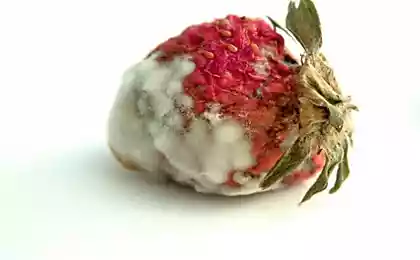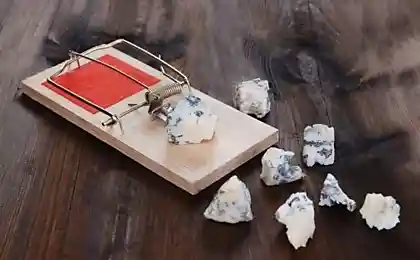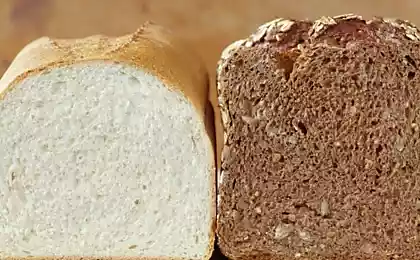224
Careful! Mold: eat or throw away
Mold A colony of microscopic fungi that can appear and develop on almost any surface. There is probably no person who would not face mold in his life, but not so many who know how dangerous this neighborhood is.
Scientists distinguish about 200 thousand species of mold fungi, about two dozen of them live in our living quarters, many are able to cause significant harm to the human body. Many diseases are a consequence of the fact that a person lives near mold or too often intersects with it: fungal skin lesions (mycosis), poisoning, rhinitis, bronchitis and lung diseases, liver and gastrointestinal tract diseases, pediatric diathesis, allergies in various forms, turning into asthma, even cancer...
Mold fungi in their composition have active enzymes that can decompose almost any organic substances. First of all, the surface on which mold was formed is destroyed. At the same time, dangerous organic acids, toxic waste products of fungi are released into the environment. And if mold fungi enter the body, then their enzymes destroy the cell membranes, opening them to any viruses and bacteria, and disrupt the metabolism, causing poisoning and disease.
How can mold get into the body?
The most direct - through the mouth, nose and skin. That is, when eating moldy foods, inhaling contaminated air and direct contact with mold. Unfortunately, even in a relatively clean room in one cubic meter of air can be up to 500 spores that settle on the surface of objects and germinate under favorable conditions (poor ventilation, high humidity and heat over +20 degrees). There are also types of mold that can live at low temperature and humidity.
Where does mold come from?
A favorite place, such as the bathroom. Mold can settle on wooden and leather objects, on paper, on walls and ceilings, on fabrics, in pots of indoor plants, on food. Mold multiplies at an incredible rate, capturing the nearest surfaces – in a small area, the number of fungi actively forming new spores quickly reaches several billion.
How to protect yourself from mold?
In no case should you eat food affected by mold! It only at first glance seems that if you cut a speck of mold from a loaf of bread, bread can be safely eaten. This is not so, the loaf is completely affected - the mushroom has grown deep inside, and the spores have already dotted the surface. If even on bread you can not see mold stains, but he smells of it – such bread can not be eaten.
Often, hard cheese in the refrigerator is covered with specks of mold - even in such conditions, its spores manage to sprout! And oddly enough, there are researchers who believe that such cheese can be used as food after heat treatment (for pizza, etc.) or by cutting off the affected surface with a thick layer (up to 1 cm). We will not argue with scientists, it is better to buy cheese in small portions and eat fresh, without waiting for the appearance of mold.
For reference.
There are delicacy varieties of cheese with mold, on which it is grown artificially and in sterile conditions, using more or less harmless to the body types of mold. Cheese and cheese that is moldy in the refrigerator are two big differences. By the way, people suffering from allergies or asthma, such a delicacy is extremely undesirable. Never pity jam that has at least a speck of mold on the surface, and do not think that it can be boiled and disinfected in this way.It's a mistake. Throw it away, health is more expensive!
Microscopic fungi and their spores inside the affected product are even more numerous than on the surface. Heat treatment destroys only part of the fungi, and the toxic products of their vital activity (scientists have identified about 100 of their species!) are stable low-molecular compounds that are not destroyed by boiling.
The same rule applies to berries, fruits, vegetables. If there are moldy berries in the container with berries, it is better to throw everything out, the spores have already been eliminated, you can easily poison yourself. If there are mold spots on fruits or vegetables, rotten areas - the same thing, send them without regret to the garbage can. No compromises!
Of course, a small piece of mold affected product will not lead to death, but harm will bring, disrupting the normal functioning of the gastrointestinal tract and liver and forcing the body once again to fight toxins. Of course, not everything is so hopeless in this confrontation, nature prudently endowed a person with natural protection from mold fungi.
It is a useful microflora inhabiting our body - on the skin, on the mucous membranes, inside the body. But if its balance is disturbed, and immunity is reduced, the consequences will sooner or later be felt. Therefore, on the one hand, much depends on personal immunity, and on the other - on the number and type of mold in the room.
How to prevent the appearance of mold and how to deal with it, if it still appeared?
We know what conditions are conducive to the emergence of this unnecessary neighborhood, so our task is to make them unfavorable. In the bathroom, you need to establish good ventilation, often ventilate this room, especially after taking a bath or shower.
Pay special attention to ventilation in the bathroom, if there are pipes of centralized hot and cold water supply, condensate often acts on them, contributing to the appearance of dampness.
In the kitchen, when cooking, close the door, turn on the hood or, if it is not, open the window. Then other rooms will not get evaporation, contributing to increased humidity.
Ventilate the living rooms regularly in dry weather.
Furniture in the rooms should not be placed close to the walls, especially outside. When there is a minimum gap between the wall and furniture, there is a high probability of condensation due to poor ventilation.
Wash clothes thoroughly dry before you put in the closet, otherwise mold will comfortably be placed on warm shelves.
Wash the dishes in the dryer or wipe dry, then dampness will not appear in the kitchen cabinets.
Mold fungi are afraid of the effects of temperatures above +40 degrees. This should be used in the fight against it.
Places where mold is found, it is desirable to clean with a wet sponge, and then treat hot (40 - 60 degrees) 4% soda solution.
Buffet, kitchen cabinets, bread, refrigerator is generally useful for prevention to periodically treat with a hot solution of soda, and then wipe with table vinegar and ventilate.
If, under all preventive measures, mold appears on wooden furniture, this means that wood was used for its manufacture, not treated with an antiseptic or initially affected by mold. With such furniture you will have to part, it is impossible to remove mold from it, but it is easy to get a source of fungal spores.
If mold spots appeared on the ceiling, walls, then you need to carefully remove the colonies of fungi along with the old plaster and apply a special tool to combat mold, observing precautions, according to the attached instructions. Then make the necessary repairs with the use of antifungal drugs (separately or as part of building materials).
Mold is an insidious guest in the house, but its appearance can be prevented. If you properly dry the rooms and prevent the appearance of dampness in them, then mold will not be there. In a clean, dry, well-heated and ventilated apartment, she will not be able to live. published
Author: Irina Lukyanchik
P.S. And remember, just by changing our consumption – together we change the world!
Join us on Facebook, VKontakte, Odnoklassniki
Source: shkolazhizni.ru/health/articles/66517/
Scientists distinguish about 200 thousand species of mold fungi, about two dozen of them live in our living quarters, many are able to cause significant harm to the human body. Many diseases are a consequence of the fact that a person lives near mold or too often intersects with it: fungal skin lesions (mycosis), poisoning, rhinitis, bronchitis and lung diseases, liver and gastrointestinal tract diseases, pediatric diathesis, allergies in various forms, turning into asthma, even cancer...
Mold fungi in their composition have active enzymes that can decompose almost any organic substances. First of all, the surface on which mold was formed is destroyed. At the same time, dangerous organic acids, toxic waste products of fungi are released into the environment. And if mold fungi enter the body, then their enzymes destroy the cell membranes, opening them to any viruses and bacteria, and disrupt the metabolism, causing poisoning and disease.
How can mold get into the body?
The most direct - through the mouth, nose and skin. That is, when eating moldy foods, inhaling contaminated air and direct contact with mold. Unfortunately, even in a relatively clean room in one cubic meter of air can be up to 500 spores that settle on the surface of objects and germinate under favorable conditions (poor ventilation, high humidity and heat over +20 degrees). There are also types of mold that can live at low temperature and humidity.
Where does mold come from?
A favorite place, such as the bathroom. Mold can settle on wooden and leather objects, on paper, on walls and ceilings, on fabrics, in pots of indoor plants, on food. Mold multiplies at an incredible rate, capturing the nearest surfaces – in a small area, the number of fungi actively forming new spores quickly reaches several billion.
How to protect yourself from mold?
In no case should you eat food affected by mold! It only at first glance seems that if you cut a speck of mold from a loaf of bread, bread can be safely eaten. This is not so, the loaf is completely affected - the mushroom has grown deep inside, and the spores have already dotted the surface. If even on bread you can not see mold stains, but he smells of it – such bread can not be eaten.
Often, hard cheese in the refrigerator is covered with specks of mold - even in such conditions, its spores manage to sprout! And oddly enough, there are researchers who believe that such cheese can be used as food after heat treatment (for pizza, etc.) or by cutting off the affected surface with a thick layer (up to 1 cm). We will not argue with scientists, it is better to buy cheese in small portions and eat fresh, without waiting for the appearance of mold.
For reference.
There are delicacy varieties of cheese with mold, on which it is grown artificially and in sterile conditions, using more or less harmless to the body types of mold. Cheese and cheese that is moldy in the refrigerator are two big differences. By the way, people suffering from allergies or asthma, such a delicacy is extremely undesirable. Never pity jam that has at least a speck of mold on the surface, and do not think that it can be boiled and disinfected in this way.It's a mistake. Throw it away, health is more expensive!
Microscopic fungi and their spores inside the affected product are even more numerous than on the surface. Heat treatment destroys only part of the fungi, and the toxic products of their vital activity (scientists have identified about 100 of their species!) are stable low-molecular compounds that are not destroyed by boiling.
The same rule applies to berries, fruits, vegetables. If there are moldy berries in the container with berries, it is better to throw everything out, the spores have already been eliminated, you can easily poison yourself. If there are mold spots on fruits or vegetables, rotten areas - the same thing, send them without regret to the garbage can. No compromises!
Of course, a small piece of mold affected product will not lead to death, but harm will bring, disrupting the normal functioning of the gastrointestinal tract and liver and forcing the body once again to fight toxins. Of course, not everything is so hopeless in this confrontation, nature prudently endowed a person with natural protection from mold fungi.
It is a useful microflora inhabiting our body - on the skin, on the mucous membranes, inside the body. But if its balance is disturbed, and immunity is reduced, the consequences will sooner or later be felt. Therefore, on the one hand, much depends on personal immunity, and on the other - on the number and type of mold in the room.
How to prevent the appearance of mold and how to deal with it, if it still appeared?
We know what conditions are conducive to the emergence of this unnecessary neighborhood, so our task is to make them unfavorable. In the bathroom, you need to establish good ventilation, often ventilate this room, especially after taking a bath or shower.
Pay special attention to ventilation in the bathroom, if there are pipes of centralized hot and cold water supply, condensate often acts on them, contributing to the appearance of dampness.
In the kitchen, when cooking, close the door, turn on the hood or, if it is not, open the window. Then other rooms will not get evaporation, contributing to increased humidity.
Ventilate the living rooms regularly in dry weather.
Furniture in the rooms should not be placed close to the walls, especially outside. When there is a minimum gap between the wall and furniture, there is a high probability of condensation due to poor ventilation.
Wash clothes thoroughly dry before you put in the closet, otherwise mold will comfortably be placed on warm shelves.
Wash the dishes in the dryer or wipe dry, then dampness will not appear in the kitchen cabinets.
Mold fungi are afraid of the effects of temperatures above +40 degrees. This should be used in the fight against it.
Places where mold is found, it is desirable to clean with a wet sponge, and then treat hot (40 - 60 degrees) 4% soda solution.
Buffet, kitchen cabinets, bread, refrigerator is generally useful for prevention to periodically treat with a hot solution of soda, and then wipe with table vinegar and ventilate.
If, under all preventive measures, mold appears on wooden furniture, this means that wood was used for its manufacture, not treated with an antiseptic or initially affected by mold. With such furniture you will have to part, it is impossible to remove mold from it, but it is easy to get a source of fungal spores.
If mold spots appeared on the ceiling, walls, then you need to carefully remove the colonies of fungi along with the old plaster and apply a special tool to combat mold, observing precautions, according to the attached instructions. Then make the necessary repairs with the use of antifungal drugs (separately or as part of building materials).
Mold is an insidious guest in the house, but its appearance can be prevented. If you properly dry the rooms and prevent the appearance of dampness in them, then mold will not be there. In a clean, dry, well-heated and ventilated apartment, she will not be able to live. published
Author: Irina Lukyanchik
P.S. And remember, just by changing our consumption – together we change the world!
Join us on Facebook, VKontakte, Odnoklassniki
Source: shkolazhizni.ru/health/articles/66517/























